|
The Sound of the Old
World
by Bob Brooke
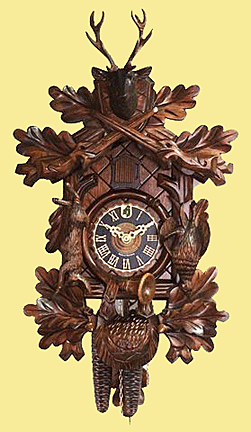 Everyone
knows the familiar sound of the cuckoo clock on the hour and the
half hour. There’s something unique about that sound—not the harsh
bim bam of some clocks or the loud chime of others, but a soft
cuckoo, cuckoo. Everyone
knows the familiar sound of the cuckoo clock on the hour and the
half hour. There’s something unique about that sound—not the harsh
bim bam of some clocks or the loud chime of others, but a soft
cuckoo, cuckoo.
It is widely believed that Franz Anton Ketterer designed and built
the first cuckoo clock in his village of Schonwald in the Black
Forest of Germany. However, the history of this unique clock dates
back even further to around 1630 in the village of Triberg.
Glassmaking was a traditional craft of the Black Forest. According
to legend, a peddler who sold glass made in the region, returned
from a selling trip with a clock from Bohemia, now the Czech
Republic. The province of Baden-Wiirttemburg lies deep in the Black
Forest. Winters there are long, dark, cold. and with deep snowfalls.
The weather limits the forestry and farming during this season, so a
cottage clock industry grew there.
The local citizens copied the Bohemian clock and made the tools to
craft it. Clockmakers assembled the clocks according to their own
patterns and styles. Each made his own parts which weren’t
interchangeable with any other maker’s. By the late 18th century,
the clocks were a profitable export for the region and the villagers
sold them as far away as Russia.
The
First Cuckoo Clock
What came first, the cuckoo or the clock? Up
to the 1730s, the Black Forest clockmakers produced simple clocks.
In 1738 Franz Ketterer from the village of Schönwald decided to
build a cuckoo for his clocks. So the bird with the original sound
“cuckoo cuckoo” was born. German clockmakers made the call of the
cuckoo the same way it is today, with two bellows sending air
through pipes, much like a church pipe organ.
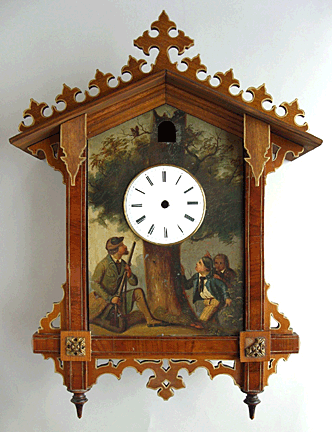 The
first clocks were rather primitive. They had only 12-hour movements
made of wood, including the moving parts. Many of the clocks had
square faces painted with watercolor. But as time went on, cuckoo
clock design and decoration grew more sophisticated. The bird’s
wings and beaks became animated and some even sported applied
feathers. The themes decorated the clocks were only limited to the
imaginations of the painters who did their faces. Scenes included
those showing hunting, family, and military motifs. Some even had
porcelain columns and enameled dials. The
first clocks were rather primitive. They had only 12-hour movements
made of wood, including the moving parts. Many of the clocks had
square faces painted with watercolor. But as time went on, cuckoo
clock design and decoration grew more sophisticated. The bird’s
wings and beaks became animated and some even sported applied
feathers. The themes decorated the clocks were only limited to the
imaginations of the painters who did their faces. Scenes included
those showing hunting, family, and military motifs. Some even had
porcelain columns and enameled dials.
As the popularity of the cuckoo clock increased, clockmakers began
replacing some of the wooden movement pieces with metal and brass.
This increased their durability and ensured that they would last
longer. This advance in technology increased the number of clocks
one woodcarver could make six times over the next 100 years.
By the late 19th century, cuckoo clockmaking had become an industry.
Families would live and work together in large cottages, each
individual working on the parts of the clock they specialized in
with some making the frames, some making the clockworks, and others
making and painting dials, making chains and gongs, and finishing
metal parts. Some carved decorations while others assembled the
movements, and still others fitted the movements in the cases.
Types
of Cuckoo Clocks
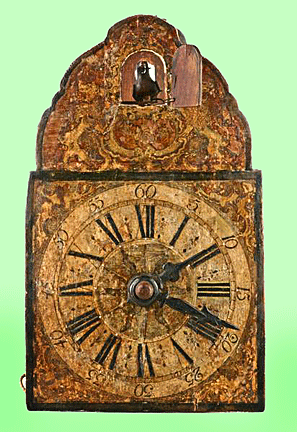 During
the latter part of the 18th century, the woodcarvers of the Black
Forest produced over a half million cuckoo clocks per year—each made
by hand. Clockmakers were so busy, they couldn’t ensure that all
their orders would be filled on time. During
the latter part of the 18th century, the woodcarvers of the Black
Forest produced over a half million cuckoo clocks per year—each made
by hand. Clockmakers were so busy, they couldn’t ensure that all
their orders would be filled on time.
The wood casing Is the primary feature that distinguishes the cuckoo
clock. Clockmakers used the wood of the linden tree, a hardwood that
grows in Europe, as well as walnut. They would purchase the woods
well in advance so that they could be aged for two years.
The now traditional Black Forest clock design, the "Schilduhr" or
shield clock, had a painted flat square wooden face behind which the
clockmaker mounted the clockworks. On top of the square was usually
a semicircle of highly decorated painted wood which contained the
door for the cuckoo. These usually depicted floral patterns,
so-called “Rosenuhren” or rose clocks, and often had a painted
column on either side of the dial with the numerals painted in
German Gothic style, normally by women. Others had illustrations of
fruit as well. There was no cabinet surrounding the clockwork in
this model. This design was the most prevalent between the end of
the 18th century and the first half of the 19th century. These
timekeepers were typically sold from door to door by "Uhrenträger"
or clock peddlers who would carry the dials and movements on their
backs in huge backpacks. About half of all 18th-century cuckoo
clocks were shield clocks.
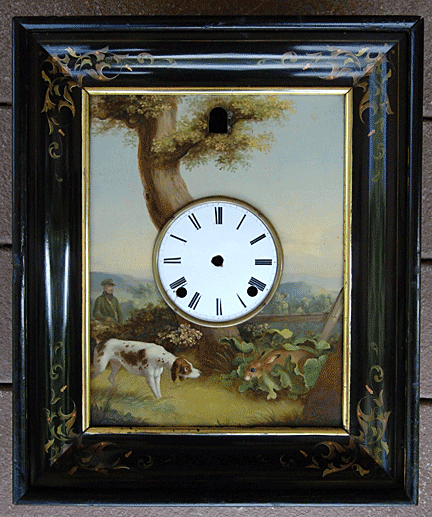 From
the 1850s to the 1870s, Black Forest clockmakers created another
type of clock known as "Rahmenuhr" or framed clock. As the name
suggests, these wall cuckoo clocks consisted of a picture frame,
usually with a typical Black Forest scene painted on a piece of wood
or metal. Common themes included hunting, love, family, death,
birth, mythology, military and Christian religious scenes.
Clockmakers often used works by painters such as Johann Baptist
Laule and Carl Heine to decorate the fronts of this and other types
of clocks. The painting was almost always protected by a sheet of
glass and some models displayed a person or an animal with blinking
or flirty eyes as well, being operated by a simple mechanism worked
by means of the swinging pendulum. The cuckoo normally popped out of
the painted scene to announce the hour. From
the 1850s to the 1870s, Black Forest clockmakers created another
type of clock known as "Rahmenuhr" or framed clock. As the name
suggests, these wall cuckoo clocks consisted of a picture frame,
usually with a typical Black Forest scene painted on a piece of wood
or metal. Common themes included hunting, love, family, death,
birth, mythology, military and Christian religious scenes.
Clockmakers often used works by painters such as Johann Baptist
Laule and Carl Heine to decorate the fronts of this and other types
of clocks. The painting was almost always protected by a sheet of
glass and some models displayed a person or an animal with blinking
or flirty eyes as well, being operated by a simple mechanism worked
by means of the swinging pendulum. The cuckoo normally popped out of
the painted scene to announce the hour.
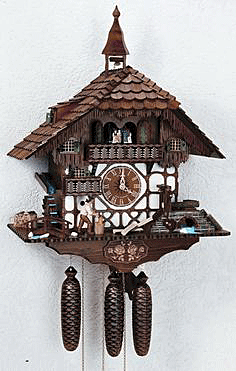 The
"chalet" style cuckoo clock originated at the end of the 19th
century in Switzerland. Made in the shape of a typical Swiss chalet,
some also had a cuckoo bird and other types of animated figurines,
such as woodcutters, moving beer drinkers, and turning water wheels.
Some "traditional" style cuckoo clocks also feature a music box and
dancing figurines. There are three basic styles, named after the
type of traditional house depicted—the Black Forest chalet, Swiss
chalet, with two types, the "Brienz" and the "Emmental," and finally
the Bavarian chalet. The
"chalet" style cuckoo clock originated at the end of the 19th
century in Switzerland. Made in the shape of a typical Swiss chalet,
some also had a cuckoo bird and other types of animated figurines,
such as woodcutters, moving beer drinkers, and turning water wheels.
Some "traditional" style cuckoo clocks also feature a music box and
dancing figurines. There are three basic styles, named after the
type of traditional house depicted—the Black Forest chalet, Swiss
chalet, with two types, the "Brienz" and the "Emmental," and finally
the Bavarian chalet.
But the popular house-shaped Bahnhäusleuhr, or railroad house clock,
virtually forced the discontinuation of other designs within a few
decades. When building the railroad through the rocky Black Forest
area around 1860, it was necessary to build many tunnels. For this,
the German Railroad hired skilled tunnel-builders from Italy.
Alongside the railroad, they built guard residences, the so-called "Bahnwärterhäusles,"
in the Italian style. Adorned with wild grape vines, they were the
inspiration for this special type of cuckoo clock.
In September 1850, the first director of the
Grand Duchy of Baden Clockmakers School in Furtwangen, Robert Gerwig,
launched a public competition to submit designs for modern
clockcases.
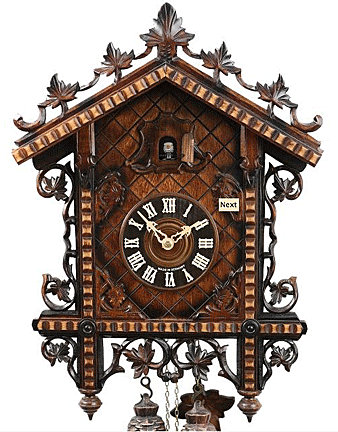 Friedrich
Eisenlohr, an architect responsible for creating the buildings along
the then new Badenian Rhine Valley Railroad, submitted a design. He
enhanced the facade of a standard railroad guard’s residence, as he
had built many of them, with a clock dial. His "Wallclock with
shield decorated by grape vines," became the prototype of today’s
popular souvenir cuckoo clocks. Friedrich
Eisenlohr, an architect responsible for creating the buildings along
the then new Badenian Rhine Valley Railroad, submitted a design. He
enhanced the facade of a standard railroad guard’s residence, as he
had built many of them, with a clock dial. His "Wallclock with
shield decorated by grape vines," became the prototype of today’s
popular souvenir cuckoo clocks.
By 1860, the Bahnhäusle style had started to develop away from its
original design towards a case with three-dimensional woodcarvings,
like the Jagdstück or "Hunt piece", design created in Furtwangen in
1861, a cuckoo clock with carved oak foliage and hunting motifs,
such as trophy animals, guns, and powder pouches.
By 1862 clockmaker Johann Baptist Beha started to enhance his richly
decorated Bahnhäusle clocks with hands carved from bone and weights
cast in the shape of fir cones. Even today this combination of
elements is characteristic of cuckoo clocks, although the hands are
usually made of wood or plastic.
Cuckoo Clock Movements
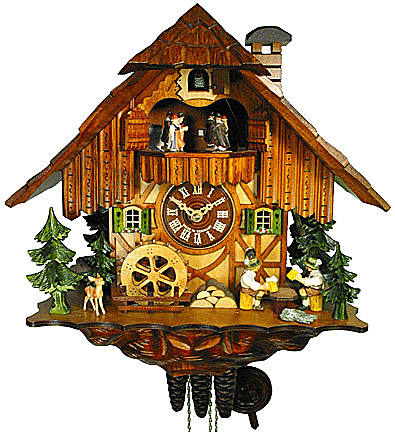 There
are two kinds of movements----30-hour and 8-day. Some have musical
devices, and play a tune on a Swiss music box after striking the
hour and half-hour. Usually the melody sounds only at full hours in
8-day clocks and both at full and half hours in the 30-hour
timepieces. There
are two kinds of movements----30-hour and 8-day. Some have musical
devices, and play a tune on a Swiss music box after striking the
hour and half-hour. Usually the melody sounds only at full hours in
8-day clocks and both at full and half hours in the 30-hour
timepieces.
Two tiny pipes in the clock, with bellows attached to their tops,
create the sound of the "cuckoo." The clock's movement activates the
bellows to send a puff of air into each pipe alternately when the
timekeeper strikes.
Antique Cuckoo Clocks
Cuckoo clocks are also highly prized antiques.
Collectors seek handcrafted ones with a provenance, but they also
hunt for the best factory-made cuckoo clocks. They especially seek
those dating from the 1850s, based on the name of the maker. Names
like Gustav Becker, the United Freiburg Clock Factory, Winterhalder
& Hofmeier, Kienzie, Junghans. and the Hamburg .American Clock
Company are among the most collectible.
Travelers on the Grand Tour purchased many of these as souvenirs of
the Black Forest of Germany, as well as western Austria, and
Switzerland. The cuckoo clock known today is the most popular form
of ornamental clock—one that’s decorative as well as functional.More
photos of the Boal Museum and Columbus Chapel.
<
More Special Features
Next Article > |
